Sicheng Yang
AutoMR: A Universal Time Series Motion Recognition Pipeline
Feb 21, 2025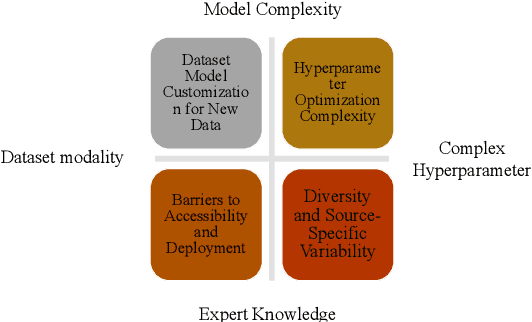
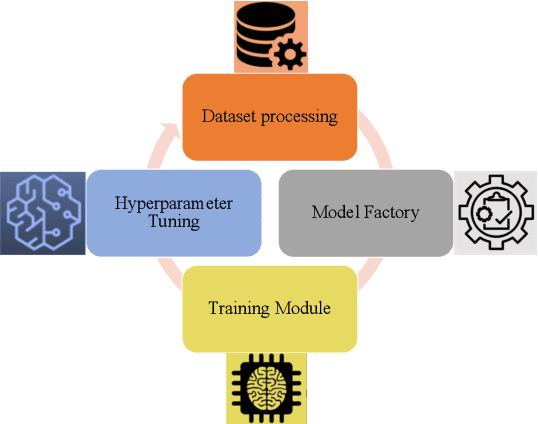

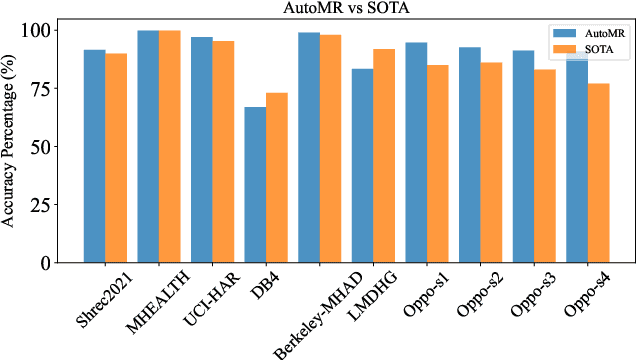
Abstract:In this paper, we present an end-to-end automated motion recognition (AutoMR) pipeline designed for multimodal datasets. The proposed framework seamlessly integrates data preprocessing, model training, hyperparameter tuning, and evaluation, enabling robust performance across diverse scenarios. Our approach addresses two primary challenges: 1) variability in sensor data formats and parameters across datasets, which traditionally requires task-specific machine learning implementations, and 2) the complexity and time consumption of hyperparameter tuning for optimal model performance. Our library features an all-in-one solution incorporating QuartzNet as the core model, automated hyperparameter tuning, and comprehensive metrics tracking. Extensive experiments demonstrate its effectiveness on 10 diverse datasets, achieving state-of-the-art performance. This work lays a solid foundation for deploying motion-capture solutions across varied real-world applications.
Duo Streamers: A Streaming Gesture Recognition Framework
Feb 17, 2025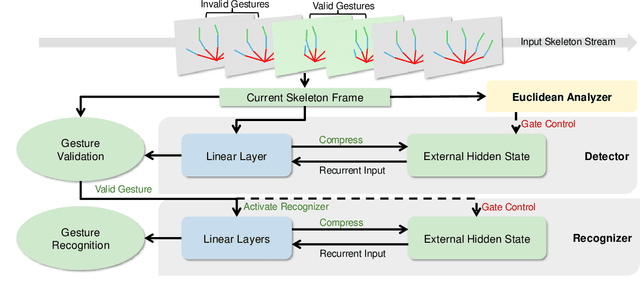
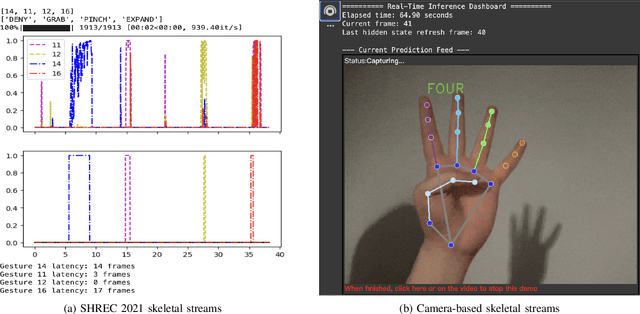


Abstract:Gesture recognition in resource-constrained scenarios faces significant challenges in achieving high accuracy and low latency. The streaming gesture recognition framework, Duo Streamers, proposed in this paper, addresses these challenges through a three-stage sparse recognition mechanism, an RNN-lite model with an external hidden state, and specialized training and post-processing pipelines, thereby making innovative progress in real-time performance and lightweight design. Experimental results show that Duo Streamers matches mainstream methods in accuracy metrics, while reducing the real-time factor by approximately 92.3%, i.e., delivering a nearly 13-fold speedup. In addition, the framework shrinks parameter counts to 1/38 (idle state) and 1/9 (busy state) compared to mainstream models. In summary, Duo Streamers not only offers an efficient and practical solution for streaming gesture recognition in resource-constrained devices but also lays a solid foundation for extended applications in multimodal and diverse scenarios.
VinT-6D: A Large-Scale Object-in-hand Dataset from Vision, Touch and Proprioception
Jan 06, 2025



Abstract:This paper addresses the scarcity of large-scale datasets for accurate object-in-hand pose estimation, which is crucial for robotic in-hand manipulation within the ``Perception-Planning-Control" paradigm. Specifically, we introduce VinT-6D, the first extensive multi-modal dataset integrating vision, touch, and proprioception, to enhance robotic manipulation. VinT-6D comprises 2 million VinT-Sim and 0.1 million VinT-Real splits, collected via simulations in MuJoCo and Blender and a custom-designed real-world platform. This dataset is tailored for robotic hands, offering models with whole-hand tactile perception and high-quality, well-aligned data. To the best of our knowledge, the VinT-Real is the largest considering the collection difficulties in the real-world environment so that it can bridge the gap of simulation to real compared to the previous works. Built upon VinT-6D, we present a benchmark method that shows significant improvements in performance by fusing multi-modal information. The project is available at https://VinT-6D.github.io/.
Cross-conditioned Diffusion Model for Medical Image to Image Translation
Sep 13, 2024Abstract:Multi-modal magnetic resonance imaging (MRI) provides rich, complementary information for analyzing diseases. However, the practical challenges of acquiring multiple MRI modalities, such as cost, scan time, and safety considerations, often result in incomplete datasets. This affects both the quality of diagnosis and the performance of deep learning models trained on such data. Recent advancements in generative adversarial networks (GANs) and denoising diffusion models have shown promise in natural and medical image-to-image translation tasks. However, the complexity of training GANs and the computational expense associated with diffusion models hinder their development and application in this task. To address these issues, we introduce a Cross-conditioned Diffusion Model (CDM) for medical image-to-image translation. The core idea of CDM is to use the distribution of target modalities as guidance to improve synthesis quality while achieving higher generation efficiency compared to conventional diffusion models. First, we propose a Modality-specific Representation Model (MRM) to model the distribution of target modalities. Then, we design a Modality-decoupled Diffusion Network (MDN) to efficiently and effectively learn the distribution from MRM. Finally, a Cross-conditioned UNet (C-UNet) with a Condition Embedding module is designed to synthesize the target modalities with the source modalities as input and the target distribution for guidance. Extensive experiments conducted on the BraTS2023 and UPenn-GBM benchmark datasets demonstrate the superiority of our method.
Co-Speech Gesture Video Generation via Motion-Decoupled Diffusion Model
Apr 02, 2024
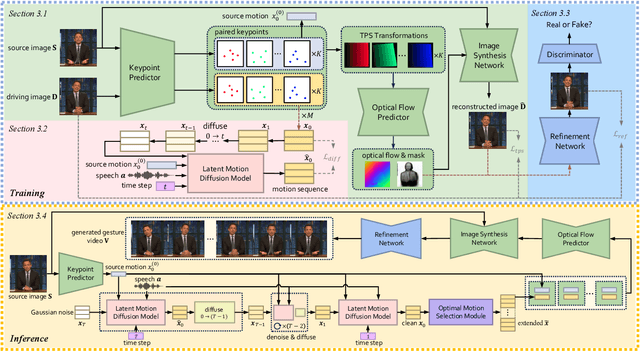

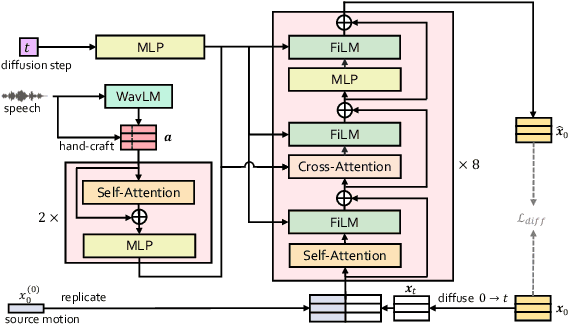
Abstract:Co-speech gestures, if presented in the lively form of videos, can achieve superior visual effects in human-machine interaction. While previous works mostly generate structural human skeletons, resulting in the omission of appearance information, we focus on the direct generation of audio-driven co-speech gesture videos in this work. There are two main challenges: 1) A suitable motion feature is needed to describe complex human movements with crucial appearance information. 2) Gestures and speech exhibit inherent dependencies and should be temporally aligned even of arbitrary length. To solve these problems, we present a novel motion-decoupled framework to generate co-speech gesture videos. Specifically, we first introduce a well-designed nonlinear TPS transformation to obtain latent motion features preserving essential appearance information. Then a transformer-based diffusion model is proposed to learn the temporal correlation between gestures and speech, and performs generation in the latent motion space, followed by an optimal motion selection module to produce long-term coherent and consistent gesture videos. For better visual perception, we further design a refinement network focusing on missing details of certain areas. Extensive experimental results show that our proposed framework significantly outperforms existing approaches in both motion and video-related evaluations. Our code, demos, and more resources are available at https://github.com/thuhcsi/S2G-MDDiffusion.
MambaTalk: Efficient Holistic Gesture Synthesis with Selective State Space Models
Mar 14, 2024


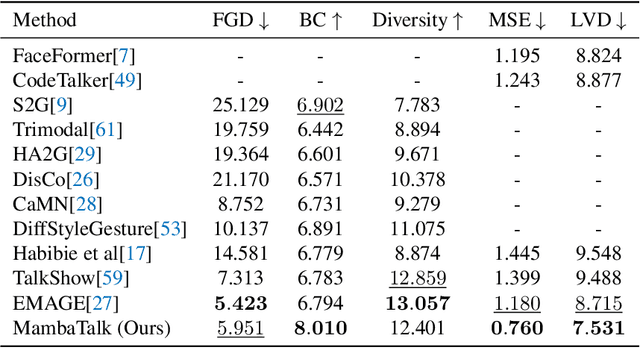
Abstract:Gesture synthesis is a vital realm of human-computer interaction, with wide-ranging applications across various fields like film, robotics, and virtual reality. Recent advancements have utilized the diffusion model and attention mechanisms to improve gesture synthesis. However, due to the high computational complexity of these techniques, generating long and diverse sequences with low latency remains a challenge. We explore the potential of state space models (SSMs) to address the challenge, implementing a two-stage modeling strategy with discrete motion priors to enhance the quality of gestures. Leveraging the foundational Mamba block, we introduce MambaTalk, enhancing gesture diversity and rhythm through multimodal integration. Extensive experiments demonstrate that our method matches or exceeds the performance of state-of-the-art models.
Freetalker: Controllable Speech and Text-Driven Gesture Generation Based on Diffusion Models for Enhanced Speaker Naturalness
Jan 07, 2024



Abstract:Current talking avatars mostly generate co-speech gestures based on audio and text of the utterance, without considering the non-speaking motion of the speaker. Furthermore, previous works on co-speech gesture generation have designed network structures based on individual gesture datasets, which results in limited data volume, compromised generalizability, and restricted speaker movements. To tackle these issues, we introduce FreeTalker, which, to the best of our knowledge, is the first framework for the generation of both spontaneous (e.g., co-speech gesture) and non-spontaneous (e.g., moving around the podium) speaker motions. Specifically, we train a diffusion-based model for speaker motion generation that employs unified representations of both speech-driven gestures and text-driven motions, utilizing heterogeneous data sourced from various motion datasets. During inference, we utilize classifier-free guidance to highly control the style in the clips. Additionally, to create smooth transitions between clips, we utilize DoubleTake, a method that leverages a generative prior and ensures seamless motion blending. Extensive experiments show that our method generates natural and controllable speaker movements. Our code, model, and demo are are available at \url{https://youngseng.github.io/FreeTalker/}.
Chain of Generation: Multi-Modal Gesture Synthesis via Cascaded Conditional Control
Dec 26, 2023Abstract:This study aims to improve the generation of 3D gestures by utilizing multimodal information from human speech. Previous studies have focused on incorporating additional modalities to enhance the quality of generated gestures. However, these methods perform poorly when certain modalities are missing during inference. To address this problem, we suggest using speech-derived multimodal priors to improve gesture generation. We introduce a novel method that separates priors from speech and employs multimodal priors as constraints for generating gestures. Our approach utilizes a chain-like modeling method to generate facial blendshapes, body movements, and hand gestures sequentially. Specifically, we incorporate rhythm cues derived from facial deformation and stylization prior based on speech emotions, into the process of generating gestures. By incorporating multimodal priors, our method improves the quality of generated gestures and eliminate the need for expensive setup preparation during inference. Extensive experiments and user studies confirm that our proposed approach achieves state-of-the-art performance.
UnifiedGesture: A Unified Gesture Synthesis Model for Multiple Skeletons
Sep 13, 2023



Abstract:The automatic co-speech gesture generation draws much attention in computer animation. Previous works designed network structures on individual datasets, which resulted in a lack of data volume and generalizability across different motion capture standards. In addition, it is a challenging task due to the weak correlation between speech and gestures. To address these problems, we present UnifiedGesture, a novel diffusion model-based speech-driven gesture synthesis approach, trained on multiple gesture datasets with different skeletons. Specifically, we first present a retargeting network to learn latent homeomorphic graphs for different motion capture standards, unifying the representations of various gestures while extending the dataset. We then capture the correlation between speech and gestures based on a diffusion model architecture using cross-local attention and self-attention to generate better speech-matched and realistic gestures. To further align speech and gesture and increase diversity, we incorporate reinforcement learning on the discrete gesture units with a learned reward function. Extensive experiments show that UnifiedGesture outperforms recent approaches on speech-driven gesture generation in terms of CCA, FGD, and human-likeness. All code, pre-trained models, databases, and demos are available to the public at https://github.com/YoungSeng/UnifiedGesture.
The DiffuseStyleGesture+ entry to the GENEA Challenge 2023
Aug 26, 2023Abstract:In this paper, we introduce the DiffuseStyleGesture+, our solution for the Generation and Evaluation of Non-verbal Behavior for Embodied Agents (GENEA) Challenge 2023, which aims to foster the development of realistic, automated systems for generating conversational gestures. Participants are provided with a pre-processed dataset and their systems are evaluated through crowdsourced scoring. Our proposed model, DiffuseStyleGesture+, leverages a diffusion model to generate gestures automatically. It incorporates a variety of modalities, including audio, text, speaker ID, and seed gestures. These diverse modalities are mapped to a hidden space and processed by a modified diffusion model to produce the corresponding gesture for a given speech input. Upon evaluation, the DiffuseStyleGesture+ demonstrated performance on par with the top-tier models in the challenge, showing no significant differences with those models in human-likeness, appropriateness for the interlocutor, and achieving competitive performance with the best model on appropriateness for agent speech. This indicates that our model is competitive and effective in generating realistic and appropriate gestures for given speech. The code, pre-trained models, and demos are available at https://github.com/YoungSeng/DiffuseStyleGesture/tree/DiffuseStyleGesturePlus/BEAT-TWH-main.
 Add to Chrome
Add to Chrome Add to Firefox
Add to Firefox Add to Edge
Add to Edge